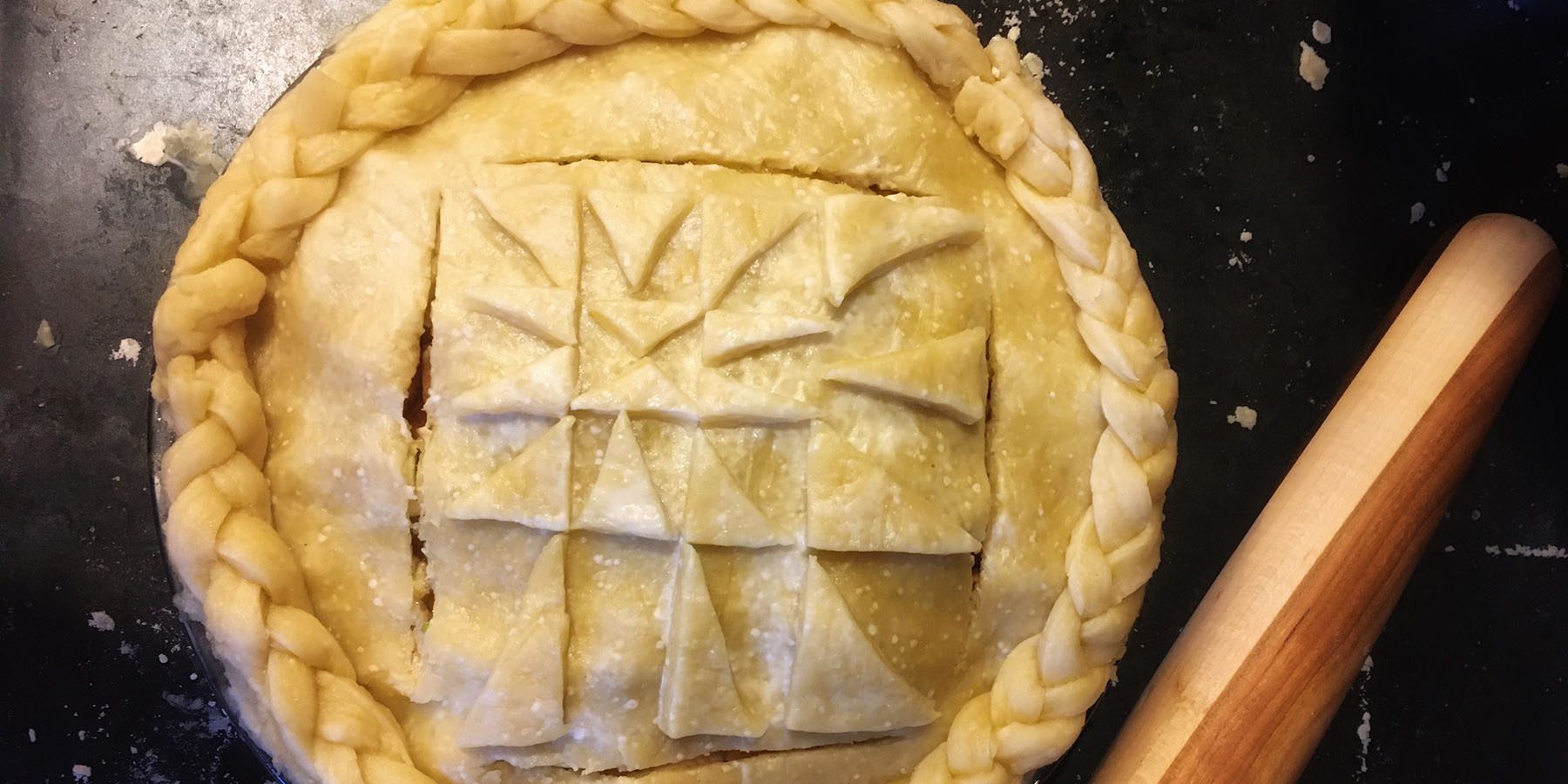Author: Carolyn Bauer
Last week, in a need to busy my hands and quiet my mind, I set to baking my partner Ben’s and my favorite aromatic all-American dessert: apple pie. Ben and I both follow a vegan diet. We are also strict adherents to ending each day with a sweet treat, preferably homemade. As the pie baked, cozy comforts of cinnamon, ginger and fresh apples wafted through our Burlington house, wrapping us in temporary feeling of normalcy. It was exactly what we needed at that moment. (Image 1)
Never one to leave a piecrust unadorned, I pieced together the Shelburne Museum logo to decorate the sweet treat. Whilst creating the logo, I was taken with the preposterous idea of what objects from Shelburne Museum’s permanent collection I would borrow in order to take my creation to the next level, or as my colleagues have coined the expression after our founder—Electra Havemeyer Webb—“Electra-fy” it. (Image 2)
A decorative, hand-carved pie crimper—used to cut, press, and pierce pie pastry—would have perfected my pie’s edges. (Image 3) Shelburne Museum has an incredible collection of unusually elaborate pie crimpers carved from whale bone, ivory, shells or other materials found out at sea by sailors. Men commonly carved this kitchen tool for their loved ones back home while they were out on extended whaling voyages. Shelburne Museum’s scrimshaw pie crimpers feature multiple pattered wheels, carved eagles’ heads, intricate hands, and even a nude female form.(Image 4)
To transform my rustic looking apple pie into a more refined presentation, a large slice would look more striking on the museum’s Delft Charger: Tea Scene with Oriental Figures tin-glazed earthenware serving plate from Delft, Holland. (Image 5) The cobalt blue decorations on the opaque white surface are characteristic of Delft, who successfully imitated the coveted blue and white designs of expensive imported porcelains at a much more affordable price. A potter inspired by the East created this plate capturing an imaginary scene of a tea ceremony. Around the rim of the plate are images of women and children thrilled by the process of making, brewing, and enjoying tea. Personally, I think the apple pie would contrast nicely on this beautiful plate, really making the slice shine.
To finish the staging and serving of this Shelburne Museum-inspired pie, with new influences and a nod to the Far East, an assortment of Tiffany & Co. flatware service designed by Edward Moore would have to be loaned to me. Electra Havemeyer Webb’s father, Henry Osborne Havemeyer, an art collector of Asian objects, befriended several artists and collectors—notably Louis Comfort Tiffany of Tiffany & Co. and his chief designer Edward C. Moore—who were equally inspired by Eastern art and culture. These talented men later became important artistic advisors to Havemeyer. At the time of his marriage to Louisine Elder, in 1883, H.O. Havemeyer commissioned Tiffany & Co. and Moore to design an original silver flatware service.(Image 6) Moore created a set of sixty-two pieces, wherein no two where alike, and stylistically inspired by Japanese art and design. Each piece in the set incorporates a different plant, bird, insect, fish, or animal motifs made of various colored precious and base metals applied to the handles of the knives, forks, and spoons. This remarkable flatware and service—which includes a pie server—celebrates the Havemeyers’ shared enthusiasm for the arts while also establishing their refined taste in high quality in design, materials and craftsmanship.
Please find below our recipe for (vegan) apple pie, adapted from our favorite chef, Isa Chandra Moskowitz’s cookbook Vegan Pie in the Sky: 75 Out-of-This-World Recipes for Pies, Tarts, Cobblers, and More. With limited staple supplies at our local grocery stores right now—such as butter, eggs and milk—it is a great time to try vegan baking if you have not already!
How would you all dress up your baked goods with objects from Shelburne Museum’s collection?
Olive Oil Pie Crust
Makes one 9-inch top and bottom crust (plus extra for decorating!)
2 1/2 cups all-purpose flour
¾ teaspoon salt
2/3 cup olive oil, partially frozen
8-8 ½ tablespoons ice water
1 tablespoon apple cider vinegar
Prepare the olive oil by pouring the oil into a plastic container and placing into the freezer. Freeze the oil until it looks somewhat opaque and congealed—like a sorbet consistency—which takes about 1 hour.
In a large mixing bowl, combine the flour and salt together. Working quickly, piece in the olive oil, cutting it into the flour mixture. You want to make a pastry dough that look a little pebbly.
In a large mixing cup, add 8 tablespoons of ice water and apple cider vinegar together. Slowly drizzle the water and apple cider vinegar into the dough by the tablespoon, and stir. Stop adding water when the dough can keep its hold and you are able to form two soft balls.
Press the two halves into disks and roll out the dough with a rolling pin into thin circles. If you are not ready to use the dough right away, simply wrap it in plastic wrap and place the fridge until ready.
Amazing Apple Pie
Makes 8 servings (but good luck not finishing it all in a couple days)
1 recipe Olive Oil Pie Crust
Filling:
6 cups peeled apples (Granny Smith or whatever you have), sliced ¼ inch thick (between 2-3 pounds)
1/3 cup brown sugar
½ cup white sugar
1-2 teaspoons cinnamon (to personal taste)
½ – 1 teaspoon ground ginger (to personal taste)
1/8 teaspoon ground cloves
3 tablespoons all-purpose flour
Dash of salt
Topping:
½ – 1 teaspoon ground cinnamon
2 tablespoons sugar
2 tablespoons non-dairy milk (plain almond milk or any other nondairy milk of personal preference)
In a large bowl, mix together all of the filling ingredients. Toss the filling together with your hands to make sure there is an even coating over the apples.
Preheat the oven to 425 degrees Fahrenheit
Add one prepared pie shell to a 9 inch pie pan. Add the filling mixture to the prepared pie shell. Cover the pie with the prepared top crust. Pinch the edges of the two pie crusts together, sealing the pie, and trim off any excess dough. Make at least 5 small slits in the middle of the pie to allow steam to escape during baking.
Add any extra dough flourishes to your top piecrust. Be creative! Add a little water to the back of the added pie dough decorations backside for better adhesion to the crust.
Mix together the cinnamon and sugar for the topping. Brush the nondairy milk all over the top pf the pie, and sprinkle on top the cinnamon-sugar mixture.
Bake the apple pie for 25 minutes, and then lower the heat to 350 degrees Fahrenheit and bake for an additional 30 minutes.
Place the pie on a cooling rack and let it cool a bit before serving.
Enhance the apple pie experience by serving a large slice with coconut whipped cream or nondairy vanilla ice cream! Enjoy!


Carolyn Bauer
Associate Curator, Shelburne Museum
I inherited my sweet tooth naturally. My grandmother served homemade desserts after every meal for family of six children: cookies and bars after breakfast and lunch, and pies and cakes after dinner. During my adolescence, I was obsessed with chocolate—specifically dark chocolate—the way some children might take to a certain sport or profess love for a boy band. I collected and cherished cookbooks similar to how I now covet my art and art history texts. For school reports and presentations, mine would typically be about a famous chef, a food group, or feature an elaborate baking demonstration. I was even on track to entering the culinary world professionally, enrolling in our local vocational-technical school’s culinary and pasty arts program for my high school experience, when my family and I abruptly moved from rural southern New Jersey to less-rural southern Wisconsin a couple weeks shy of starting. In hindsight, this was all for the best, as I quickly redirected my passion from culinary arts to visual art, and I found a lasting adoption for a plant-based diet.
Cooking flavorful vegan meals and baking indulgent desserts continues to be one of my favorite activities and a source of great comfort. I count myself incredibly fortunate to be able to continue exercising such a “hobby” during these uncertain times. The COVID-19 pandemic has created devastating effects on so many individuals and families right now, and it is not lost on me that many people are finding themselves with limited access to food right now.

